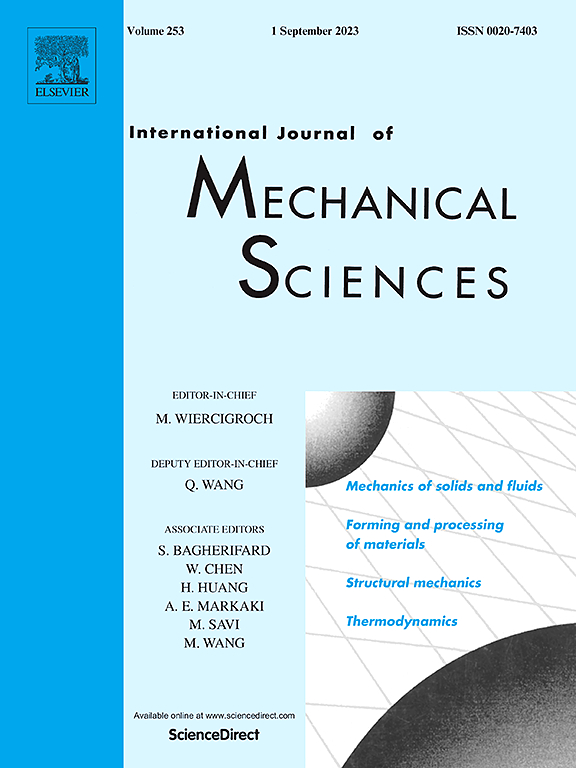Undeformed chip thickness modeling in EUVAG considering wheel topography evolution
IF 9.4
1区 工程技术
Q1 ENGINEERING, MECHANICAL
International Journal of Mechanical Sciences
Pub Date : 2025-06-24
DOI:10.1016/j.ijmecsci.2025.110540
引用次数: 0
Abstract
To investigate the evolution of wheel topography and grinding performance under elliptical ultrasonic vibration-assisted grinding (EUVAG), silicon carbide (SiC) ceramics were selected as the material for processing. Comparative experiments involving wheel wear tests and grinding performance tests were conducted for both conventional grinding (CG) and EUVAG. This study proposes and establishes a novel method for determining the undeformed chip thickness distribution under EUVAG, utilizing it as a key parameter to link the evolution of wheel topography with grinding outcomes. The undeformed chip thickness model takes into account the dynamic effects of wheel and the unevenness of grain height, and is further modified by considering the material elastic-plastic micro deformation. First, to elucidate the influence of elliptical ultrasonic vibration on the evolution of wheel topography, the wear patterns of grains on wheel surface were characterized, including statistical analyses of the wear platform and cutting height of grains. Compared to CG, the occurrence of clearance surfaces and grain detachment is delayed in EUVAG, and there is an increase of 11.2 % to 25.1 % in the wear platform area Auw. Subsequently, the coupled effects of wheel wear states, elliptical ultrasonic vibration parameters, and grinding process parameters on key grinding performance indicators were analyzed from the perspective of undeformed chip thickness distribution. The results demonstrated that increasing the wheel speed to reduce μ2 is an effective approach for achieving lower grinding forces in EUVAG, the reduction amplitude is from 25 % to 46 %. Expanding the range of μ2 can significantly reduce grinding specific energy. For applications requiring low surface roughness, controlling μ2 at a lower mean value with a more uniform distribution can be achieved by increasing the wheel speed and decreasing the workpiece feed rate. The optimal surface roughness is 0.187 μm when vs = 24 m/s. Reducing the range of μ2 and the proportion of undeformed chip thickness facilitates a higher plastic removal ratio, while lowering μ1 enhances plastic removal efficiency. The improvement in material removal rate achieved by EUVAG was observed to increase initially and then decrease with progressive wear of wheel, and the optimal improvement is 17.9 % achieved at wear state 4. Finally, by analyzing the mapping relationships between machining results and the distribution characteristics of undeformed chip thickness under various machining parameters, an efficient and low-damage prediction model for EUVAG of SiC ceramics was developed. It was found that the parameter combination [vs=20 m/s, vw=50 mm/min, ap=10 µm, Az=2.668 µm] provides an optimal balance between machining quality and efficiency, achieving the plastic removal with a small proportion of brittle removal, and the MRR of 37.6 × 106 µm3/mm·s.

考虑车轮形貌演化的EUVAG无变形切屑厚度建模
为了研究椭圆超声振动辅助磨削(EUVAG)下砂轮形貌和磨削性能的变化,选择碳化硅陶瓷作为加工材料。对常规磨削(CG)和EUVAG进行了砂轮磨损试验和磨削性能试验的对比试验。本文提出并建立了一种确定EUVAG下未变形切屑厚度分布的新方法,并将其作为连接砂轮形貌演变与磨削结果的关键参数。未变形切屑厚度模型考虑了砂轮的动态效应和颗粒高度的不均匀性,并考虑了材料的弹塑性微变形进行了进一步修正。首先,为了阐明椭圆超声振动对车轮形貌演化的影响,对车轮表面晶粒的磨损模式进行了表征,包括对磨损平台和晶粒切割高度的统计分析;与CG相比,EUVAG延迟了间隙面和晶粒脱落的发生,磨损平台区域Auw增加了11.2% ~ 25.1%。随后,从未变形切屑厚度分布的角度,分析了砂轮磨损状态、椭圆超声振动参数、磨削工艺参数对关键磨削性能指标的耦合影响。结果表明,提高砂轮转速降低μ2是降低EUVAG磨削力的有效途径,减小幅度为25% ~ 46%。扩大μ2范围可以显著降低磨削比能。对于表面粗糙度要求较低的应用场合,可以通过提高砂轮转速和降低工件进给速度来实现μ2均值较低且分布更均匀。当vs = 24 m/s时,最佳表面粗糙度为0.187 μm。减小μ2范围和未变形切屑厚度所占比例有利于提高塑性去除率,减小μ1有利于提高塑性去除效率。EUVAG对材料去除率的提高随车轮磨损程度的增加先增加后降低,在磨损状态4时达到了17.9%的最佳改善。最后,通过分析不同加工参数下加工结果与未变形切屑厚度分布特征之间的映射关系,建立了高效、低损伤的SiC陶瓷EUVAG预测模型。结果表明,参数组合[vs=20 m/s, vw=50 mm/min, ap=10µm, Az=2.668µm]在加工质量和效率之间达到了最佳平衡,实现了塑性去除和脆性去除比例较小,MRR为37.6 × 106µm3/mm·s。
本文章由计算机程序翻译,如有差异,请以英文原文为准。
求助全文
约1分钟内获得全文
求助全文
来源期刊

International Journal of Mechanical Sciences
工程技术-工程:机械
CiteScore
12.80
自引率
17.80%
发文量
769
审稿时长
19 days
期刊介绍:
The International Journal of Mechanical Sciences (IJMS) serves as a global platform for the publication and dissemination of original research that contributes to a deeper scientific understanding of the fundamental disciplines within mechanical, civil, and material engineering.
The primary focus of IJMS is to showcase innovative and ground-breaking work that utilizes analytical and computational modeling techniques, such as Finite Element Method (FEM), Boundary Element Method (BEM), and mesh-free methods, among others. These modeling methods are applied to diverse fields including rigid-body mechanics (e.g., dynamics, vibration, stability), structural mechanics, metal forming, advanced materials (e.g., metals, composites, cellular, smart) behavior and applications, impact mechanics, strain localization, and other nonlinear effects (e.g., large deflections, plasticity, fracture).
Additionally, IJMS covers the realms of fluid mechanics (both external and internal flows), tribology, thermodynamics, and materials processing. These subjects collectively form the core of the journal's content.
In summary, IJMS provides a prestigious platform for researchers to present their original contributions, shedding light on analytical and computational modeling methods in various areas of mechanical engineering, as well as exploring the behavior and application of advanced materials, fluid mechanics, thermodynamics, and materials processing.
 求助内容:
求助内容: 应助结果提醒方式:
应助结果提醒方式:


